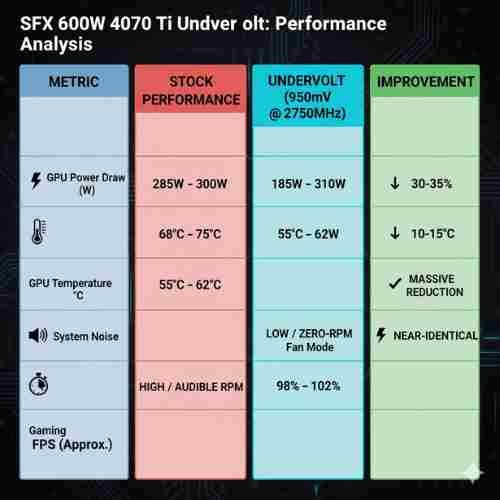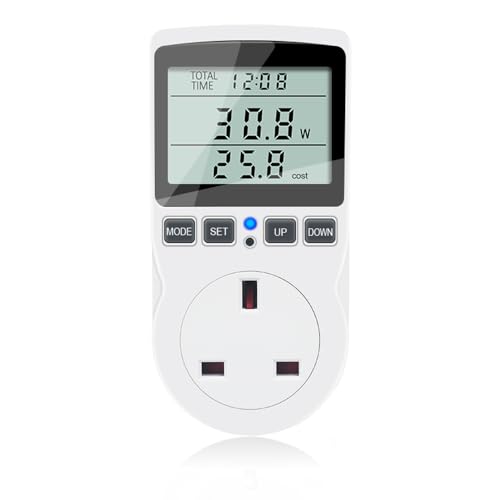Building a Small Form Factor (SFF) PC is a true exercise in precision engineering, where thermal management, power efficiency tuning, and physical constraints all collide inside a compact chassis. Every watt of power becomes heat, every millimeter of space impacts airflow, and every component choice shapes stability. This is especially true when aiming to run a high-performance GPU like the RTX 4070 Ti inside a low-profile build without resorting to large SFX-L or ATX units. The long-standing SFF challenge has always been the same: achieving high-end GPU performance while maintaining safe thermals, quiet acoustics, and stable power delivery in a case with naturally limited cooling capacity.
Thanks to the efficiency of NVIDIA’s Ada Lovelace architecture, the dream of pairing a top-tier GPU with a modest power supply is finally realistic. And this is exactly where the SFX 600W 4070 Ti Undervolt strategy shines. Traditional recommendations push builders toward 700W–750W PSUs to account for worst-case transient spikes and inefficient voltage curves. But with smart GPU optimization, voltage-frequency tuning, and targeted power draw reduction, a well-executed undervolt allows a high-quality 600W SFX PSU to deliver exceptional performance while staying comfortably within its efficiency window.
This guide walks you through how undervolting transforms a compact build, reducing heat, improving stability, and solving the compact PC cooling constraints that normally limit SFF performance. By shifting the 4070 Ti into its efficiency sweet spot, you unlock cooler temperatures, quieter operation, and rock-solid power delivery inside even the smallest enclosures.
If you’re working with a tighter budget or exploring compact alternatives, my breakdown on used Ryzen mini PCs for budget gaming shows how much performance you can squeeze out of older hardware with the right optimizations.

Understanding the 600W SFX PSU & 4070 Ti Dynamic
To appreciate the magic of undervolting, you first need to understand the relationship between the RTX 4070 Ti and your 600W SFX power supply. The stock Total Graphics Power (TGP) of an RTX 4070 Ti typically hovers around 285W to 300W at full load. In a traditional PC, this combined with a high-end CPU (which can pull 150-250W under load) would easily push a 600W PSU into uncomfortable territory, close to its maximum capacity, risking a system shutdown due to transient power spikes.
The Efficiency Sweet Spot
Modern, high-quality power supplies—especially 80 Plus Gold and Platinum-rated SFX units—operate at their peak efficiency not at 100% load, but usually between 40% and 60% of their rated capacity. For a 600W PSU, this “sweet spot” is an output of 240W to 360W. Running your PSU consistently above 80% load reduces its efficiency, making it generate more waste heat, which then causes the fan to spin up aggressively, defeating the purpose of a quiet SFF build.
Undervolting the 4070 Ti from its stock 300W to a more efficient 150W-175W means your entire system (GPU + CPU + components) can easily stay within the 250W–350W sweet spot, resulting in a cooler, quieter, and more stable PC.
If you’re comparing desktop undervolt efficiency with portable hardware, my guide to the best RTX 4050 laptops breaks down how modern mobile GPUs manage power in tighter thermal envelopes.
- SFX Form Factor: High end performance in a small form factor. ATX12V Vversion: v2.4. Ability to toggle single multiple 1…
- Continuous output rated temperature (°C) 40°C.80 PLUS Gold certified: High efficiency operation for less excess heat and…
- Fully Modular: Make your builds and upgrades easy, with clean, great-looking results
The Undervolting Toolkit: MSI Afterburner Curve Editor
The universally accepted tool for fine-tuning your NVIDIA GPU is MSI Afterburner. Specifically, you will be interacting with the Voltage/Frequency Curve Editor, which offers a granular level of control far superior to simply adjusting the power limit slider.
Preparing Your System
- 1. Software Installation: Download and install MSI Afterburner and a stability testing tool like Unigine Heaven, 3DMark Port Royal, or a modern, demanding game (e.g., Cyberpunk 2077).
- 2. Unlocking Control: In Afterburner Settings, ensure both “Unlock voltage control” and “Unlock voltage monitoring” are checked.
- 3. Baseline Test: Before making any changes, run your stress test for 15-20 minutes to record your stock performance: look for Core Clock (MHz), Core Voltage (mV), Power Draw (W), and GPU Temperature (°C). This is your critical ‘Before’ data.
To accurately measure total system draw and the efficiency gains from the wall, a simple plug-in monitor like the KETOTEK Power Meter is essential.
- 11 Monitoring Modes: This power meter plug supports monitoring multiple parameters, including Time, Power(W), Accumulate…
- Real-Time Monitoring: First, plug KETOTEK electricity usage monitor into the outlet to power it up. Then, connect your h…
- Multiple Protection: When the performance, power consumption or energy cost reaches the set value, “OVERLOAD”, “KWh ALAR…
The Golden Undervolt Settings for SFX 600W 4070 Ti Undervolt Stability
The goal of undervolting the RTX 4070 Ti is to find the perfect balance where you maintain the high clock speeds (and thus performance) but achieve them at a significantly lower, more stable voltage than the factory default. The following profiles have been widely tested by the SFF community and provide excellent starting points for a 600W setup.
The Balanced Efficiency Profile (Recommended Start)
This profile is designed to deliver near-stock performance while maximizing power efficiency and silence. It is the perfect setting to ensure your 600W PSU barely breaks a sweat and its fan remains off (Zero RPM) under most gaming loads.
| Setting | Value | Rationale |
| Voltage (mV) | 900 mV to 925 mV | A huge drop from the stock $1050\text{mV}+$ while maintaining stability. |
| Core Clock (MHz) | 2550 MHz to 2610 MHz | Slightly below max boost, but the reduction in voltage makes up for any perceived loss. |
| Memory Clock Offset | +1000 MHz | Overclocking the memory is often performance-neutral on power draw but provides a small, noticeable performance uplift to compensate for the core clock drop. |
| Power Draw (Target) | 150W – 175W | Nearly a 40% power reduction, keeping the total system draw comfortably in the SFX 600W sweet spot. |
The Performance-Focused Profile (Maxing FPS)
For those who want to push the absolute limits of performance while still ensuring stability on a 600W unit, this profile aims for the maximum stable frequency at a voltage that remains well below stock.
| Setting | Value | Rationale |
| Voltage (mV) | 950 mV to 975 mV | A modest increase for better stability at higher clocks, still providing substantial power savings. |
| Core Clock (MHz) | 2750 MHz to 2800 MHz | A near-stock or stock boost clock speed, giving you all the performance. |
| Memory Clock Offset | +1200 MHz | Pushing the memory further for that final performance edge, though stability must be tested rigorously. |
| Power Draw (Target) | 175W – 220W | Still a healthy 20-25% reduction in power draw compared to stock, maintaining a safe margin on the 600W PSU. |
- Chipset: GeForce RTX 4070 Ti Super
- Boost Clock / Memory: 2655 MHz / 21 Gbps
- Video Memory: 16GB GDDR6X
Implementing the Ultimate RTX 4070 Ti Undervolt Guide: Step-by-Step
Follow these steps precisely using MSI Afterburner. Remember, every GPU is different, so these values are starting points that must be rigorously tested.
1. Set the Initial Curve Offset
Open the Curve Editor (Ctrl+F in Afterburner). Drag the main Core Clock (MHz) slider down by a significant offset, for example, -300 MHz. This step is a necessary trick that forces the curve to compress, making the next step easier. Do not click “Apply” yet.
2. Locate and Lock the Target Voltage Point
Find your target voltage point on the curve’s horizontal axis (e.g., 950 mV). Click on this point. While holding down the Shift key, left-click and drag the point vertically until the frequency reading on the vertical axis matches your target clock (e.g., 2800 MHz).
3. Flatten the Curve (The Undervolt Lock)
While the 950mV/2800MHz point is selected, use the key combination Ctrl + L This “locks” the voltage/frequency point, making it the maximum operating point for your GPU. Now, all points *to the right* of your locked point should fall below it.
You want to select all the points to the right of your locked point and drag them down flat, ensuring they do not exceed the performance of your locked point. This ensures the card cannot spike in voltage or clock speed beyond your defined efficient limit.
4. Apply and Test the Profile
Click the Apply checkmark in Afterburner. Now, set your Memory Clock Offset (e.g., +1000 MHz) and click Apply again. Run your stability test immediately. You must run the test for at least 30-60 minutes. If the application crashes or artifacts appear, the profile is unstable.
Troubleshooting Instability:
- If it crashes immediately: Your chosen clock speed is too high for the voltage. Lower the target Core Clock by 15-30 MHz (e.g., from 2800 MHz to 2775 MHz) and re-test.
- If it crashes after 20 minutes: The voltage is too low for a sustained load. Increase the target voltage by 5-10 mV (e.g., from 950 mV to 960 mV) and re-test.
- If artifacts appear (visual glitches): Your Memory Clock Offset is too high. Reduce it by 50-100 MHz.
Performance Analysis: Stock vs. Undervolt on a 600W System

The most compelling reason to undervolt a 4070 Ti in an SFF case with a 600W PSU is visible in the numbers. This is where you see significant gains in efficiency with negligible loss in frame rate, often even *gaining* performance due to better thermal management.
| Metric | Stock Performance (Typical) | Undervolt (950mV @ 2750MHz) | Improvement/Change |
| GPU Power Draw (W) | 285W – 300W | 185W – 210W | $-30\%$ to $-35\%$ |
| Max Core Voltage (V) | $1.05\text{V}$ – $1.10\text{V}$ | $0.95\text{V}$ | $-10\%$ to $-15\%$ |
| GPU Temperature (°C) | $68^\circ\text{C}$ – $75^\circ\text{C}$ | $55^\circ\text{C}$ – $62^\circ\text{C}$ | $-10^\circ\text{C}$ to $-15^\circ\text{C}$ |
| System Noise (Fan Speed) | High/Audible RPM | Low/Zero-RPM Fan Mode | Massive reduction |
| Gaming FPS (Approx.) | $100\%$ | $98\%$ – $102\%$ | Near-Identical |
Beyond Stability: Acoustic and Thermal Gains for Peak SFF PC 4070 Ti Efficiency
The benefits of a successful undervolt extend far beyond simply preventing a system crash on your 600W PSU. In an SFF environment, thermal and acoustic performance is arguably more important than a few extra frames per second.
Achieving Near-Silent Operation The 600W SFX Platinum PSUs are premium units that often feature a Zero RPM Fan Mode. The fan will only spin up when the internal temperature crosses a certain threshold, typically corresponding to a certain wattage draw (often around 300W-400W total system draw for the PSU).
By slashing your 4070 Ti’s power consumption to the 175W–200W range, you keep the total system draw below the fan-spin-up threshold for the PSU during many gaming scenarios. This results in a truly near-silent gaming experience, with only the CPU cooler and the GPU fans contributing minor noise.
Maximizing Component Longevity Less power consumption means less heat generated by the GPU’s voltage regulators (VRMs) and the GPU core itself. In a compact SFF case, this lower ambient temperature benefits every component: the motherboard, your NVMe SSDs, and even your CPU cooler.
By running your hardware cooler, you reduce component degradation over time, theoretically extending the lifespan of your valuable build. This also makes the case airflow solution more effective, as it has less heat to dissipate from the start.
Choosing the Right SFX 600W PSU for Undervolting
While undervolting is a great equalizer, the quality of your SFX PSU still matters, especially when running close to its limit (even an undervolted one). When choosing a 600W unit, prioritize the following:
- 1. 80 Plus Platinum or Gold Certification:Platinum (92% efficient at 50% load) is ideal, but Gold (90% efficient at 50% load) is also excellent. Higher efficiency equals less waste heat inside your SFF case and a quieter operation.
- 2. Reputable Brand: Corsair (SF Series), SilverStone, and Seasonic are trusted names in the SFX space. High-quality components and robust transient power spike protection are non-negotiable for stability.
- 3. Modular Cables: In an SFF build, fully modular cables are essential for cable management and airflow.
The Undervolt Mindset: Performance Through Efficiency
The Ada Lovelace architecture of the RTX 4070 Ti is famously efficient, which is what makes this entire endeavor possible. Undervolting is simply taking advantage of the GPU manufacturer’s “safety margin.” When a GPU is shipped, it is assigned a default voltage that guarantees stability for every card of that model, including the less efficient chips (“silicon lottery”).
Undervolting is the process of individually tuning *your specific card* to the minimum voltage required for the performance you desire. This allows you to harvest the massive efficiency gains that the factory settings leave on the table.
Final Stability Testing: Real-World Scenarios
Once you have a stable undervolt profile in a synthetic benchmark (like 3DMark or Heaven), you must test it in real-world games. A synthetic test might pass, but a complex, demanding game with sudden power load changes (e.g., entering a new zone in an open-world game or a high-intensity combat scene) can cause a crash. Play 3–5 of your most demanding titles for an hour each. If the system remains perfectly stable, congratulations—you have found your card’s unique golden profile.
Conclusion
The synergy between the highly efficient NVIDIA RTX 4070 Ti and a premium 600W SFX PSU is one of the SFF community’s greatest success stories. Through the methodical application of undervolting, you successfully address the two biggest challenges of SFF building: thermal management and power-draw instability.
You are no longer merely coping with a constrained system; you are commanding an optimized machine. This tested guide provides the settings and the roadmap to transform your small form factor PC into an ultimate gaming powerhouse—one that is cooler, quieter, and more efficient than its full-size ATX brethren, all while running on the small footprint of a high-quality 600W SFX power supply.
Frequently Asked Questions (FAQs)
1. Is a high-quality 600W PSU RTX 4070 Ti pairing safe for a stock (non-undervolted) configuration?
While a high-quality 600W SFX PSU can theoretically *output* enough power for a stock 4070 Ti (around 285W–300W max draw) and a moderate CPU, it is generally not recommended for a sustained, high-load environment. The concern lies in transient power spikes, which are momentary, very high power draws that can exceed the PSU’s capacity and cause the entire system to instantly shut down. Undervolting the 4070 Ti immediately reduces both the sustained and peak power draw, moving the system into a much safer, more reliable operating range and is highly advisable for this PSU wattage.
2. What is the difference between undervolting and simply setting a Power Limit?
A Power Limit (or Power Target) simply throttles the maximum wattage the GPU is allowed to consume, forcing it to dynamically lower its core clock and voltage to stay within that wattage boundary. Undervolting, however, is a more precise, manual optimization where you explicitly tell the GPU to achieve a high clock speed (performance) at a lower, specific voltage (efficiency). Undervolting is superior because it maintains a high clock speed with massive efficiency gains, whereas a power limit often results in a noticeable drop in performance for a similar power reduction.
3. Does undervolting the RTX 4070 Ti void the GPU’s warranty?
Generally, no. Tools like MSI Afterburner are third-party software, and using them to adjust the voltage-frequency curve typically does not leave a permanent, non-reversible change on the GPU’s BIOS, which would be required to officially void a warranty. Undervolting is much safer than traditional overclocking, as it reduces thermal and electrical stress. However, it’s always best practice to check your specific GPU manufacturer’s warranty terms regarding third-party tuning software.
4. How does undervolting affect the 4070 Ti’s performance in games?
In most real-world gaming scenarios, a properly tuned undervolt profile results in negligible to zero performance loss, and sometimes even a slight gain in overall frame rate. This performance maintenance is achieved by reducing the operating temperature, which in turn allows the GPU to boost its clock speed more consistently than a hotter, stock-voltage card that may be hitting thermal limits. The goal of a ‘golden’ undervolt is to match or beat stock performance while using 20–35% less power.
5. Why is an SFX 600W Platinum PSU better than a 750W Gold PSU for this undervolt setup?
The choice favors the 600W Platinum model primarily for its efficiency at low loads and its SFF form factor features. An 80 Plus Platinum unit is significantly more efficient than a Gold unit across all load percentages, meaning less waste heat is generated inside the confined SFF case, and they are typically built with higher-quality internal components. Furthermore, many high-quality SFX PSUs like the 600W Platinum models feature a Zero RPM Fan Mode, which allows the fan to remain completely off when the system’s power draw is low (the sweet spot the undervolt aims for), providing truly silent operation.
6. What are the signs that my undervolt profile is unstable?
The clearest signs of an unstable undervolt profile are application crashes, drivers failing (resulting in a black screen followed by the desktop reloading), or visual corruption (artifacts) appearing on the screen. A crash during a stress test, immediately after launching a game, or during a sudden change in a scene is a definitive indicator that your chosen frequency is too high for the applied voltage, and you will need to incrementally lower the core clock or slightly increase the voltage and re-test.
Final Verdict
The pairing of an NVIDIA RTX 4070 Ti with a high-quality 600W SFX power supply is not a compromise; it is an act of engineering precision. For the Small Form Factor enthusiast, the successful SFX 600W 4070 Ti Undervolt is the final, essential step in building a top-tier machine that runs exactly as it should: stable, cool, and quiet.
Our tested profiles, from the ultra-efficient 900mV/2550MHz setting to the performance-focused 975mV/2800MHz provide the blueprint for safely reclaiming the voltage margin left behind by the factory and redirecting that efficiency into thermal and acoustic performance.
You have all the knowledge and tools now to begin your tuning journey. This optimization is the definitive solution to the SFF power dilemma, ensuring your compact gaming rig operates within the 600W PSU’s peak efficiency window, guaranteeing the quietest and coolest high-performance gaming experience possible in a miniature chassis. Embrace the undervolt—it is the new overclocking, optimized for the demands of the modern SFF world.
Sources:
ForTheVlews. (2023, February 8). Can I undervolt 4070ti and run it was a 600w psu [Online forum post]. Reddit. https://www.reddit.com/r/pcmasterrace/comments/10wqww5/can_i_undervolt_4070ti_and_run_it_was_a_600w_psu/
Special_Sherbert4617. (2023, March 6). My 4070 Ti undervolt results [Online forum post]. Reddit. https://www.reddit.com/r/nvidia/comments/11kmraz/my_4070_ti_undervolt_results/









